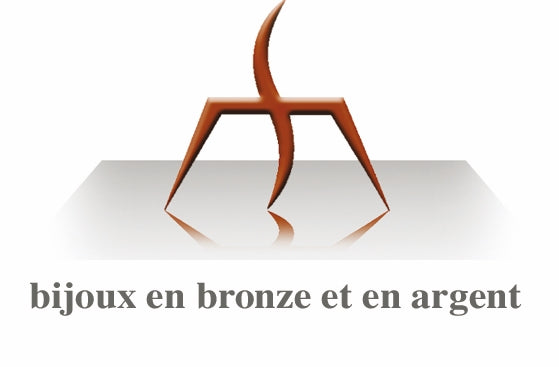handcrafted jewelry making
Different stages of the creation of a jewel
- raw materials used
- tracing the shape on the metal
- cutting
- decor
- shaping
- silver solder
- setting of finishing stones
raw materials used

Bronze and silver come in the form of plates of different thicknesses (from 4/10° of mm to 2 mm) and wires that can be stretched to the diameter you want using a sector. The metal is hardened when you buy it, you have to anneal it to work it by heating it to around 700°, the oxidized wires are.
tracing the shape on the metal

We will mainly use the ruler, the scriber or the compass and sometimes metal shapes to trace on the metal. It is often preferable to anneal it before tracing because the line is much more visible on the oxidized metal.
the cut
In our workshop, no laser cutting or machines connected to a computer… it is done by hand with shears or a bocfil saw.
the decor

One of the important attractions of the jewels we create is their decoration. It can be made with punches or worked at the melting temperature of the metal. Awls are steel tools of different shapes that leave a mark embedded in the metal when struck with a chiseling hammer. The work at melting temperature is done using a torch powered by butane and oxygen which produces a fine and very hot flame (more than 800°). It allows you to melt bronze threads on the jewel and thus create a unique decor. We also marry bronze and silver in a collection of bracelets, rings, pendants and earrings. The silver can be melted on the surface of the bronze to completely cover it and produce a highly original “reticulated” appearance on cooling. We also create a decoration using threads or decorated silver plates welded to the bronze, which highlights the two colors of the metals. You can find several jewels using this technique
Formatting

A jewel without thickness does not present much interest, moreover it can twist easily. This is why we give it a domed shape, sometimes hammered. To do this, we use forms dug in a tree trunk and a ball hammer or rivets and a steel dice hollowed out of half-spheres of different sizes.
silver solder

To assemble the different parts of the jewel together, we use silver solder. It exists in wires with a diameter of less than 1 mm made up of a silver-based alloy which melts at a lower temperature than 925/1000° silver or bronze. To make the assembly, it is necessary to apply borax which will guide the solder by capillarity where it must go when the parts are heated to the same temperature.
setting stones

When a stone enhances the color of the jewel, it is set. We mainly use cabochons of semi-precious stones mounted with the technique of crimping which was already practiced by the Egyptians three millennia before our time. The stone is surrounded by a band of metal which will be welded to encircle it very precisely. This setting will itself be welded to the location defined on the jewel. Just before polishing, the stone is placed in the setting, the bottom of which is lined with a paste that will allow it to be properly seated at the height that suits it. The metal of the setting is folded over the cabochon very delicately using a steel tool so that the metal-stone continuity is imperceptible. You can find several jewels with stones set HERE>>>
finishes

Once the jewel has been well worked, it is oxidized, the borax has left reddish traces at the place of the welds, it needs to be cleaned! For bronze we will use nitric acid to pickle it, for silver a pickling bath.
The angles will be rounded using abrasive discs, the surface of the metal brushed and finally the jewel will pass through a polishing wheel rubbed by cotton brushes lined with polishing pastes of different grains until giving it its final shine.

